
Jarnail Singh is the talented son of a very talented artist S. Kirpal Singh, known for his exceptional paintings of Sikh warriors and battles. Jarnail was born at Zira, distt. Ferozepur, Punjab on 12th June 1956. He graduated from Panjab University, Chandigarh. He had no formal training in art but the artistic blood of his father runs in his veins and that is the reason for his unique style of painting. He has participated in various exhibitions and one man shows in various parts of India. He won the Panjab Lalit Kala Akademi Awards in 1979 & 1980.
The following is an article by S.S.Bhatti, who is an art critic of the Tribune, Chandigarh and Principal, Chandigarh College of Architecture. His critical views about Jarnail are worth noting, and are given here with thanks.
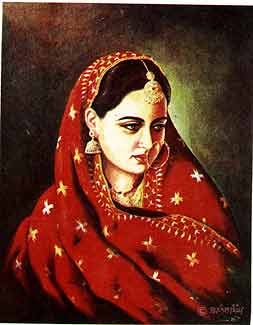
Jarnail Singh's 'Punjab Paintings'
Indian civilisation is one of the oldest in the world and its cradle was in Punjab. This, state, being the main gateway into India. was feted to be the perpetual field of battle and the first hone of all the conquerors. There is thus much in the heroic struggle which Punjab -- the sword-arm of India -- had successfully put up in fighting against the tyranny and injustice of the foreign invaders and conquerors. The Green Revolution and the amazing quantities of agricultural produce have earned this state the title of "the granary of India".
These epithets, enviable though they nay be, have lamentably relegated other significant achievements of this state, so much so that many people seem to believe that the only culture that Punjab can legitimately boast about is "agriculture". Yet, art folklore, ballads of love and war, fairs and festivals. dances, music, and Punjabi literature are what form characteristic expressions of the state's robust cultural life.
Ironically, notwithstanding the enviable martial, cultural art, and religious traditions of the state, there is a piti-able dearth of pictorial material on the Punjabi way of life and its exemplary history. It is this inspiring background which impels Jarnail singh (32) to attempt preserving what may soon be lost to posterity due to the rapid onslaught of industrialisation. His "Punjab Paintings" are thus an artist's pictorial record of "the glorious history and rich cultural heritage of Punjab".
responsible for his art training. Jarnail longs to a pathetic minority of artists who practice art as a livelihood.
A BA in History and Economics, the young painter has been participating in the annual art exhibitions of the Punjab Kala Akademi since 1975. Besides, he has already held 3 one-man shows. Jarnail paints in oils on canvas of two sizes 3ft x 4ft and 2ft x 3ft..
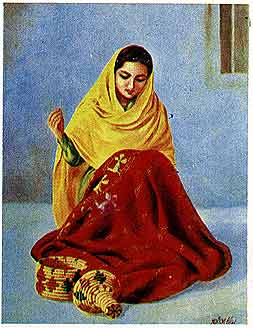
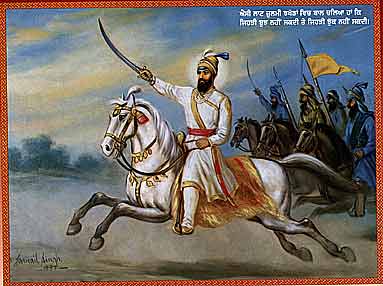
- Yet another painting belonging to the historical themes is the portrait
(icon) of Guru Tegh Bahadur. Jarnail has painted the Ninth Master highlighting
his mastery in martial arts more than his holy qualities. This is quite unusual
because all other artists have painted the Guru as a- saint absorbed in deep
meditation.
"Tegh Bahadur" was a title which Guru Har Gobind gave to his son
who had fought so valiantly against the Mughals even as a young boy. Impressed
by his virtuosity in swordsmanship the Sixth Guru had called his son "Tegh
Bahadur". which means "gallant brandisher of the sword". Garments,
sword and other details of the portrait are noteworthy.
Commendable points of Jarnail's paintings of the Punjabi way of life are the
typical mud hamlets of the state's villages, wall paintings on mud walls,
storage bins, indigenous shelves for household wares, wicker-work baskets,
the biomorphic fenestration -- above all, a placid timelessness which pervades
the Punjabi rural habitat. The best painting in the category is the one which
shows a village belle wrapped in phulkari, sitting on an uncovered wicker-work
charpoy. The composition, the colour scheme, the
expression, the exquisite detailing altogether' make this work a "masterpiece".
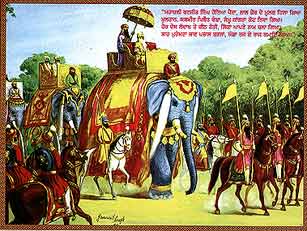
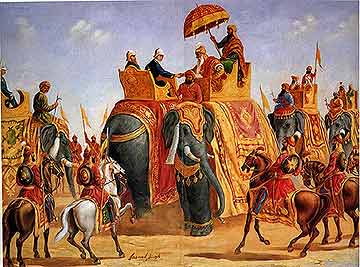
In another painting of this category,. Jarnail has depicted various aspects of the zestful lifestyle of a Punjabi village. Embroidery of phulkari, open-air group-baking of loaves of bread (roti) in indigenous mud ovens (tandoor), a banjara selling glass bracelets to young girls, curd-churning. group-singing. on dholak,swinging in Sawan, a bride's make-up, and her reception by the ladies of the in-law's house and so forth present a fairly wide range to capture the colour and variety which characterise the Punjabi lifestyle. In all of these paintings, the most beautiful objects are the wicker-work baskets, indigenous sofa (peeda), fans and other household furniture and utensils. These studies of folk motifs and handicrafts are evocative as well as "original and authentic".
From all that he has painted so far, it seems that portraiture is Jarnail's
forte. Among his portraits of Punjabi girls, women and brides, the most persistently
beautiful feature is the exquisitely painted phulkari with a -rich variety
of embroidered motifs and designs. Some of them are so realistic (for example,
the bride in a pensive mood seated with her back towards the viewer) that
one feels like touching the evocative drapery.
Jarnail has verily created a mini museum of phulkaris using an inspired painter's
repertoire of keen observation, unfailing patience and technical virtuosity.
He has included the major background colours like red, maroon and mustard
as well as the rare "blue" which are used in phulkaris. Studies
of head, ear, nose, neck and wrist ornaments are also commendable. Another
noteworthy feature is that the faces of the girls, women and brides are typically
"Punjabi" i.e. they are coy yet confident, lovely yet durable --
above all, aglow with an inner, unageing healthfulness, and uncontaminated
by the artificiality ol industrialised urban living.
Notwithstanding the merits which I have highlighted in Jarnail's work, I cannot
help making a few suggestions. He needs to do a rigorous study of human and
animal anatomy, postures, moods and figures in action. This should be Supplemented
by an assiduous application of the laws of perspective and foreshortening,
carefully established relationships of scale, space, form and structure. There
are few artists in this country who can draw or paint figures (human or animal)
in action in an authentic setting of land-scape, sky, mountains, and other
natural features
In the kind of work which Jarnail has himself chosen to accomplish, it is
all the more incumbent upon him to acquire proficiency in the art of drawing
and painting the stated elements with accuracy and authenticity..
Knowing his excellent skill in certain areas notably, phulkari painting, combined
with his "deep-rooted desire tc preserve the heroic struggles and traditions
of Punjabi on canvas", his energy and patience, his keen observation
and love of detail, his uncanny sense of colour and composition, I have absolutely
no doubt that Jarnail Singh will mature into an authentic, pictorial chronicler
of the matchless history of the people of Punjab, their art and culture, and
their unique lifestyle -- intense, robust earthly aesthetic, and unique.
Amen.